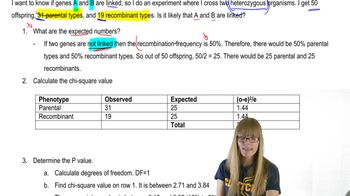Here are the essential concepts you must grasp in order to answer the question correctly.
Genetic Linkage
Genetic linkage refers to the tendency of genes located close to each other on the same chromosome to be inherited together during meiosis. When genes are syntenic, they are physically located on the same chromosome, which can lead to a lower frequency of recombination between them. If genes E and H are genetically linked, they will produce more parental gametes than recombinant gametes due to their proximity.
Recommended video:
Crossover and Recombination
Crossover is a process during meiosis where homologous chromosomes exchange segments of genetic material, leading to genetic recombination. In this scenario, with one crossover occurring between genes E and H, the resulting gametes will include both parental types and recombinant types. The frequency of these types depends on the distance between the genes; closer genes result in fewer recombinant gametes.
Recommended video:
Recombination after Single Strand Breaks
Parental and Recombinant Gametes
Parental gametes are those that contain the original combinations of alleles from the parents, while recombinant gametes have new combinations due to crossover events. In the case of the genotype EH/eh, if one crossover occurs between E and H, the expected ratio of parental to recombinant gametes can be calculated. This ratio helps determine the genetic linkage and the degree of recombination between the genes.
Recommended video:
 Verified step by step guidance
Verified step by step guidance Verified video answer for a similar problem:
Verified video answer for a similar problem:

